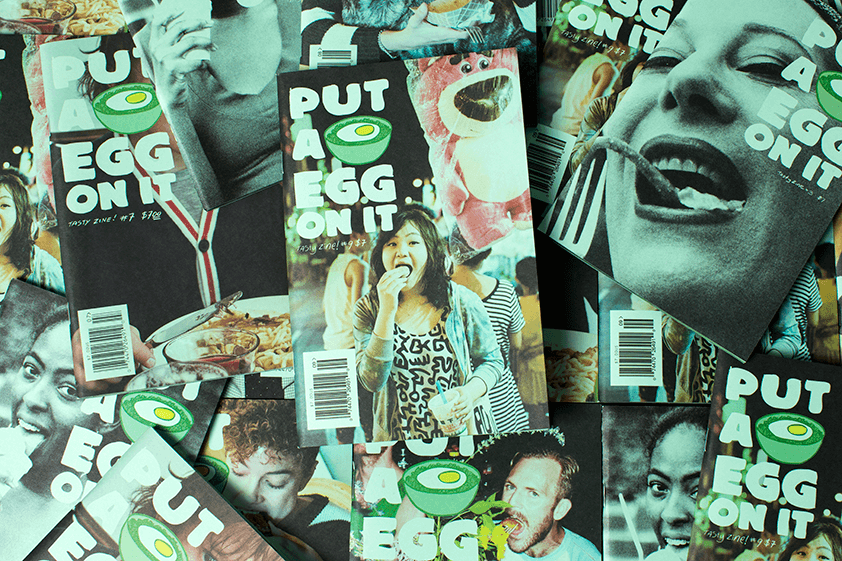
In a world where Lucky Peach can come and go, Saveur can suffer major layoffs and the future of food media looks uncertain, the occasion to celebrate an indie food magazine’s 10th birthday feels especially joyous. It’s even more joyous because Put A Egg On It has always been a breath of fresh air on the newsstand, with green pages, real-feeling photography and dinner conversations that move far from the topic at hand while always letting you know a bite is nearby. Egg always seemed cooler than the rest—aspirational not in the way of celebrity chefs and Nancy Meyers’ kitchens, but in showing that an engaged life centered around good eating didn’t have to be the stuff of only the wealthy.
The magazine was founded in 2008 by friends Sarah Keough and Ralph McGinnis, who met in college. “He was the only other person in our bad philosophy class who talked,” Keough tells me. “We started collaborating back then and have worked on zines, films, photo projects, etc. We both write and assign and edit the essays. He has a background in design and illustration and I have one in photography so the rest of the labor gets divided down those lines.” Here, Keough discusses the past and future of the magazine.
Edible Brooklyn: What inspired you to start Put A Egg On It, and what made you use “a” rather than “an”?
Sarah Keough: Ralph and I are lifelong magazine obsessives. We made zines as kids and read every cool European fashion magazine we could get our hands on, as well as old copies of Interview, Index, i-D and The Face. For a while, we had a blog called Print Fetish where we reviewed magazines and then finally we were like, enough talking about it, let’s start our own.
When considering a subject, we wanted something that was universal, a lens through which anyone could tell a story about their life. In 2008, when we were first starting out, there weren’t many little food magazines, so we decided that was as good a topic as any. We were inspired by things like Diner Journal, Butt Magazine and music fanzines from the ’80s and ’90s.
The a vs. an question is one we get a lot. For years, we would get letters from people letting us know that we had it wrong. Thanks, guys! We wrote it like we say it to each other, when arguing over who gets dinner leftovers, “no, I will take it home and put a egg on it!” And we don’t like to take ourselves too seriously.
EB: Has it gotten easier or more difficult over the last decade to run a small food magazine? What have the biggest challenges been—and the best surprises?
SK: I would say both. The explosion of indie food magazines in the world after we started helped build the market and over the years we’ve seen a lot of specialty shops pop up all over the world who sell indie food titles. Also we’re all a little different, and fans of one another, and that’s inspiring to me. Each year we keep going, we get better at planning ahead, building more of a sustainable business and growing a team of friends and collaborators. It can be hard though, the margin of error is slim and we are a very small team. One of the best surprises has been relationships we’ve made with other magazines – not just food, but indie mags in general – and the advice and support we’ve all been able to give each other.
EB: There’s so much talk in food media these days about how to be more compelling, more inclusive. Put A Egg On It has never been concerned with trends, and that seems to make it more relevant than ever now. Do you see the magazine as fitting into the food world or as something set apart from it?
SK: I think we’re outsiders, though we’ve made a lot of wonderful friends in the food world. Our position has always been that we want to let people tell the stories of their lives as they actually are. The brief we share with photographers includes this: we want documentary style photography, real but cinematic, not aspirational at all, messy, real life. We’re not interested in trends because we aren’t about food as an industry or a business, we’re about food as a vehicle for human connection.
EB: What are the magazine’s plans for the next ten years?
SK: The 10th anniversary issue will be triple the number of pages of any we’ve done before. We’re barreling into 2018 with more content and types of content and we’re just beginning to collaborate with a few brands we like. We also plan to overhaul our digital content and go from sporadic to regularly scheduled—more videos, more recipes and we have correspondents from all over—Colombia, Kenya, Belarus, Kansas, so keep an eye out for that.
SaveSave
SaveSave



